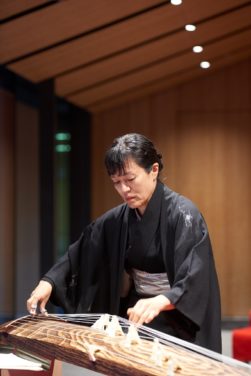It’s not a harp.
It’s a zither.
Koto is a string instrument with more than a thousand year history in Japan. A standard koto has 13 strings but the earliest koto had only five strings and was about one meter (three feet) long.

The koto body is made out of paulownia wood, is about six feet long, has movable bridges for each string, and many tunings. The instrument is played with small picks of the thumb and first two fingers of the right hand (the left meanwhile may raise the pitch or modify the tone).
From late 1960s, western music composers discovered the way to adopt Japanese traditional musical instruments into their works. At the same time, Japanese music composers tried to take western musical elements into their work.

Since it has a long history, the music of koto may vary from very old traditional Japanese music to pieces in contemporary styles. In addition, with its adjustable string bridges, it is capable of producing various scales – from typical Japanese pentatonic scales to Western music. In contemporary ensemble music, the 17 string bass koto is often used in addition to the standard 13 string koto.
Koto has been played in Oregon for quite a long time and the instrument is becoming well known in our diverse community. Oregon Koto-Kai was founded by koto master Mitsuki Dazai, who moved to Oregon in 2002. Her goal is to invite people to enjoy unusually beautiful and peaceful music.